
Chirag Gala, also spelled Çiraq Qala or Çirax Qala, which means lamp castle in Azerbaijani is a ruined ancient fortress overlooking the Caspian coastal plains north of Baku in Azerbaijan. It is located on the top of a mountain, in the Guba Forest. It was constructed by the Sassanid Persians in the 5th century, it was used as a defense for the khanate of Quba in the 18th century.

Old City or Inner City is the historical core of Baku, the capital of Azerbaijan. The Old City is the most ancient part of Baku, which is surrounded by walls. In 2007, the Old City had a population of about 3,000 people. In December 2000, the Old City of Baku, including the Palace of the Shirvanshahs and Maiden Tower, became the first location in Azerbaijan to be classified as a UNESCO World Heritage Site.
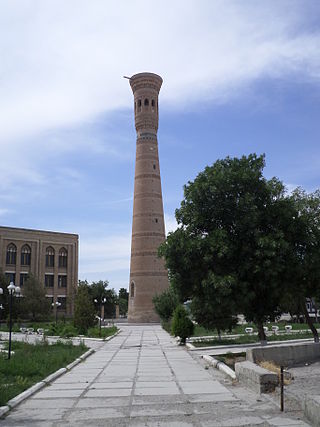
Vobkent is a city in the Bukhara Region of Uzbekistan and the capital of Vobkent District. It is famous for a minaret constructed in 1196–1198, under the reign of Ala ad-Din Tekish.

Berdkunk is a village in the Gavar Municipality of the Gegharkunik Province of Armenia.
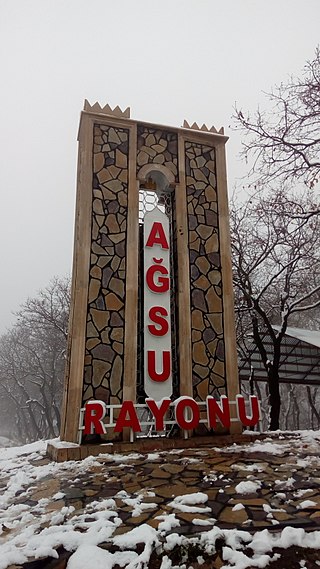
Agsu is a city in and capital of the Agsu District of Azerbaijan.

Mərdəkan (Mardakan) is a settlement and municipality in Khazar raion of Baku, Azerbaijan with a population of 25,232. It's located on the eastern Absheron Peninsula only 30 km away from capital city Baku, bounded by the Caspian Sea to the north, Shuvalan to the east, Qala to the south, and Shagan to the west. Mardakan received the status of a settlement in 1936. In 1933, Shagan village was included in the Mardakan village council, although it was separated in 1945, it was reunited in 1948, and in 1990, Shagan re-separated and received the status of a settlement.

Maştağa is a settlement and municipality in Baku, Azerbaijan. It has a population of 42,196. According to the popular historical manuscripts, the inhabitants of the village are the descendants of an ancient nomadic Turkish tribe which defeated and brought down Cyrus the Great and settled down in Baku during the 5th-6th centuries.

The Quadrangular Mardakan Fortress or the Great Mardakan Castle is a historical and architectural monument located in the Mardakan settlement of the Khazar district in Baku. It is included by the Ministry of Culture and Tourism of Azerbaijan in the list of monuments of world importance. In 2001, along with other objects of the coastal defence of the Caspian Sea, it was included in the UNESCO World Heritage Reserve List.
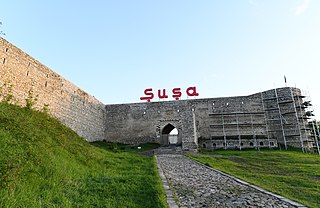
The Shusha fortress or Shushi fortress is a fortress surrounding the historical centre of Shusha, also called Shushi. The newly conquered castle town was called "Panahabad fortress" named after Panah Ali Khan who together with Melik Shahnazar was the founder of the fort. In later years, the city was just called "Fortress". A settlement at Shusha is first recorded in a 15th-century illustrated Armenian gospel which mentions the "Shushu village".

Nardaran Fortress was built in 1301 by architect Mahmud ibn Sa'd in the northern part of Absheron Peninsula. Nardaran Fortress is located 25 km north of Baku in the village of Nardaran near the town of Mashtaga. Shirvanshahs used the fortress for both observation and defense. Nardaran Mosque or Rahimakhanim sanctuary which was built in 1663 is located about 200 m from the fortress.

Ramana Tower – is a historical architectural monument located in the Ramana village of the Sabunchu district in Baku. The palace has been registered as a monument of global significance by the Ministry of Culture of Azerbaijan Republic. In 2001, along with other defensive structures of the Absheron Peninsula, Ramana Fortress was included in.

The Gala State Historical Ethnographic Reserve is a complex of museums in Baku, Azerbaijan. Inside there are three different types of museums: Museum of Archaeology and Ethnography (open-air), Castle Museum, and the Museum of Antiques. Vehicles are offered to visitors due to the spacious area of museums. There are the tours in different languages: Azerbaijani, Russian, English, German and French.

Sumug-gala is a defence castle in the Bucag neighborhood of İlisu village of Gakh region. It was built in the 17th-18th century.

The Palace of the Karabakh Khans or the Palace of Panah Ali Khan is a palace located in the historical center of the city of Shusha, the former residence of the founder of the Karabakh Khanate, Panah Ali Khan. During the reign of Panah Ali Khan, the palace was also the residence of the ruler where he lived together with his family. His son, Ibrahimkhalil Khan, together with his family and followers settled in the Palace of Ibrahimkhalil Khan built in the same period. For the eldest son of Ibrahimkhalil Khan, Mukhammedhasan Agha, another palace was built on a sheer cliff in the southeast of the Shusha plateau. In addition to these palaces, the Palace of the Khan's daughter, Natavan, and the Palace of Gara Boyuk khanim, belonging to the Khan's family, were also built in Shusha. Although in various sources the name of the Palace of the Karabakh Khan is attributed to each of these buildings, the main political residence of the Karabakh Khans was the palace-castle of the first Karabakh Khan, Panah Ali Khan.

Quadrangular Tower, or Keeper of the Fortress of Baku, is a stone keep built in the 14th century. It is part of the Old City in Baku, Azerbaijan. On August 2, 2001, the building was declared a "national architectural monument" by the Cabinet of Azerbaijan.

The Desert castles of ancient Khorezm, traditionally known as Elliq Qala, are a collection of desert fortresses in Karakalpakstan in Uzbekistan. They are included on UNESCO’s Tentative List for World Heritage Site status as the Desert Castles of Ancient Khorezm.

Galacha or Shamil-Gala is a round tower located near the village of İlisu in the Gakh region of Azerbaijan. The tower was built in the beginning of the 19th century during the Russian troops advancing into the mountains. According to the order of the Cabinet of Ministers of the Republic of Azerbaijan on the historical and cultural monument, it is considered an architectural monument of local importance.
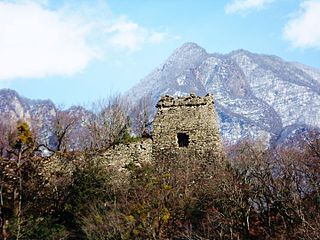
Jinli Castle or Jinli-Gala is a fortress located near the village of İlisu in the Gakh region of Azerbaijan. It was built according to some sources in the 7-9th centuries, according to others - presumably in the 18th century, during the time of continuous invasions and internal conflicts. It is also possible that the fortress was used in the beginning of the 19th century, during the clashes between the Russians and the mountain population. According to the order of the Cabinet of Ministers of the Republic of Azerbaijan on historical and cultural monuments, it constitutes an architectural monument of local importance.
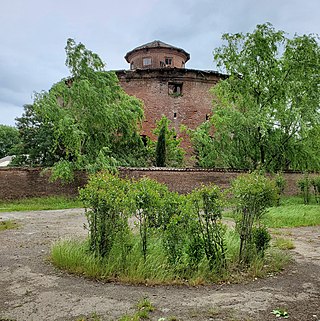
Zindan Fortress or the Round Fortress is a part of the Lankaran Fortress built in the 18th century. This one, as well as the second fortress similar to it, currently used as a lighthouse, were the southern and northern strongholds of the Lankaran Fortress’ system. After the occupation by the Russian troops, the Lankaran Fortress was destroyed, consequently the strongholds were divided. In 1869, a lantern was installed on the roof of the fortress known as the northern stronghold, and the building began to be used as a lighthouse. Currently, the lighthouse is under the jurisdiction of the Caspian Shipping Company. The Zindan Fortress was used as a prison from 1869 to 1959. According to some reports, at the beginning of the 20th century, Joseph Stalin served his sentence here. By the Decree No. 132 of the Cabinet of Ministers of the Republic of Azerbaijan, dated with 2 August 2001, the fortress is protected by the state and is included in the list of the architectural monuments.
Mammad Hasan agha palace is a historical palace located in the historical center of Shusha city. The palace was built on a steep rock in the southeast of the Shusha plateau. The palace belonged to Mammad Hasan agha, the eldest son of Ibrahim Khalil Khan, and his family members. Agha Mohammad Shah Qajar Muhammad Hasan, who captured Shusha in 1796, began to live in the Mammad Hasan agha palace, and in 1797 he was murdered in this palace by his servant Safar Ali.






















